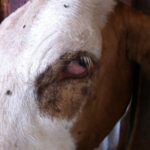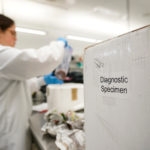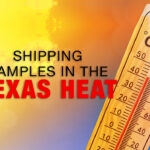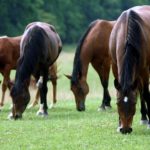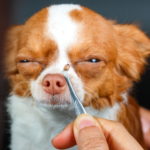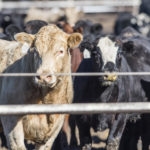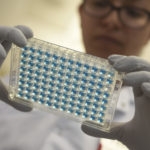Pinkeye in cattle is also known as Infectious Bovine Keratoconjuctivitis (IBK). The longer name accurately describes the fact that the conjunctivae and cornea of the eye are the tissues most often affected by this condition. Signs displayed by … [Read more...] about Pinkeye in cattle
DX Guidance
Check all the boxes: Best practices for expediting regulatory sample submissions
The Texas A&M Veterinary Medical Diagnostic Laboratory (TVMDL) works alongside the Texas Animal Health Commission (TAHC) to provide testing services in accordance to state regulations. Due to the increased volume of regulatory testing this … [Read more...] about Check all the boxes: Best practices for expediting regulatory sample submissions
Summary of Calf Diarrhea Multiplex Results from Texas Cattle, 2019-2023
Summary of Calf Diarrhea Multiplex Results from Texas Cattle, 2019-2023 Carlos Rodriguez, Epidemiology and Informatics Manager The Texas A&M Veterinary Medical Diagnostic Laboratory (TVMDL) offers a variety of testing to assist in working up … [Read more...] about Summary of Calf Diarrhea Multiplex Results from Texas Cattle, 2019-2023
Determining the cause of diarrhea in pre-weaning calves
Determining the cause of diarrhea in pre-weaning calves Alexis Thompson, DVM, PhD Pre-weaning calf diarrhea is a common concern in the beef and dairy industry and the cause may be difficult to determine. This is due to the multifactorial nature … [Read more...] about Determining the cause of diarrhea in pre-weaning calves
Basisphenoid and basioccipital bone fractures in a horse
Basisphenoid and Basioccipital Bone Fractures in a Horse Randi Gold, VMD, PhD, DACVP A 10-year-old female quarter horse flipped over backwards onto its head after being spooked. Following the incident, the patient made multiple attempts to rise … [Read more...] about Basisphenoid and basioccipital bone fractures in a horse
Avoid a night of fright: Dog owners encouraged to be aware of potentially toxic seasonal items
October is filled with treats that can make pet safety tricky. Candy, food, drinks, and decorative items rank among the spookiest of scares for pets. As such, the Texas A&M Veterinary Medical Diagnostic Laboratory (TVMDL) is encouraging dog … [Read more...] about Avoid a night of fright: Dog owners encouraged to be aware of potentially toxic seasonal items
Epidemiology of feline hemoparasites in Texas
Epidemiology of feline hemoparasites in Texas Carlos Rodriguez, Epidemiology and Informatics Manager Between 2019 and 2023, TVMDL has assisted Texas veterinarians in diagnosing 32 cases of hemotropic Mycoplasma infection and 9 cases of … [Read more...] about Epidemiology of feline hemoparasites in Texas
Diagnostic guidance: Mycoplasma testing options
Diagnostic guidance: Mycoplasma testing options Brandon Dominguez, DVM, MS, DACVPM Mycoplasma bacteria can cause a variety of symptoms in many of our animal species. These bacteria are unique because they lack a cell wall, making them challenging … [Read more...] about Diagnostic guidance: Mycoplasma testing options
Shipping samples in the Texas heat
It's hot and getting hotter. Extreme temperatures will affect the condition of samples if not shipped properly. This may lead to delays in results if samples arrive at TVMDL in an untestable condition. TVMDL encourages clients to beat the heat … [Read more...] about Shipping samples in the Texas heat
Epidemiology of systemic mycoses in Texas
Epidemiology of systemic mycoses in Texas Carlos Rodriguez, Epidemiology and Informatics Manager The Texas A&M Veterinary Medical Diagnostic Laboratory (TVMDL) assists Texas veterinarians in diagnosing an average of over 350 cases of systemic … [Read more...] about Epidemiology of systemic mycoses in Texas
Diagnostic guidance: Hemorrhagic disease in deer
Hemorrhagic disease is a viral disease caused by either the epizootic hemorrhagic disease virus or the bluetongue virus. These viruses are closely related, but genetically distinct. In North America, hemorrhagic disease is seen primarily among … [Read more...] about Diagnostic guidance: Hemorrhagic disease in deer
West Nile virus: Diagnostic Guidance for Veterinarians
Late summer is when the West Nile virus (WNV) poses the greatest threat to the health of horses in the United States. It’s important for veterinarians to educate horse owners concerning the prevention, detection and accurate diagnose of WNV. Yearly, … [Read more...] about West Nile virus: Diagnostic Guidance for Veterinarians
Too much (or too little) of a good thing: Thyroid disease testing at TVMDL
The thyroid gland serves an important function in the overall health of animals. However, it can also lead to a host of health issues if not functioning properly. The Texas A&M Veterinary Medical Diagnostic Laboratory (TVMDL) offers several … [Read more...] about Too much (or too little) of a good thing: Thyroid disease testing at TVMDL
Exercise caution prior to exhibition: Copper toxicity in show animals
Exercise caution prior to exhibition: Copper toxicity in show animals Guy Sheppard, DVM As youth prepare livestock projects for exhibition at stock shows across the state, it is important to keep in mind the possibility of copper toxicity, … [Read more...] about Exercise caution prior to exhibition: Copper toxicity in show animals
Chronic Wasting Disease testing: TVMDL’s role in protecting Texas wildlife
As the state veterinary diagnostic laboratory, the Texas A&M Veterinary Medical Diagnostic Laboratory (TVMDL) tests hundreds of thousands of samples annually. However, on the brink of each year’s deer hunting season, test numbers begin to spike … [Read more...] about Chronic Wasting Disease testing: TVMDL’s role in protecting Texas wildlife
Collecting hair for livestock drug testing
The collection of hair samples should be undertaken by a competent individual within a secure, contamination-free facility. Hair is a strong, stable tissue that is simple to collect, transport, and store. Data suggest hair is as effective a matrix as … [Read more...] about Collecting hair for livestock drug testing
West Nile virus guidance for equine practitioners
Late summer is when the West Nile virus (WNV) poses the greatest threat to the health of horses in the United States. It’s important for veterinarians to educate horse owners concerning the prevention, detection and accurate diagnose of WNV. Yearly, … [Read more...] about West Nile virus guidance for equine practitioners
March 20-26: National Animal Poison Prevention Week
Each year, National Animal Poison Prevention Week is observed the third week of March. This week is used to demonstrate safety practices and mitigation strategies to prevent pets from accidentally being exposed to potentially toxic sources. Although … [Read more...] about March 20-26: National Animal Poison Prevention Week
Diagnostic guidance: Tick-Borne Relapsing Fever
Tick-Borne Relapsing Fever (TBRF) is caused by several species of bacteria in the genus Borrelia. Similarly to Lyme disease, which is caused by Borrelia burgdorferi, these bacteria are spread by ticks and cause non-specific clinical signs. In … [Read more...] about Diagnostic guidance: Tick-Borne Relapsing Fever
How to properly prepare a blood smear
Although there have been substantial advances in benchtop hematology instrumentation for veterinary species, manual evaluation of a blood smear remains a vital part of a complete blood count (CBC). At the Texas A&M Veterinary Medical Diagnostic … [Read more...] about How to properly prepare a blood smear
Diagnostic guidance: Calf diarrhea
This post is from the TVMDL Calf Diarrhea producer handout. Diarrhea is the most prevalent illness in calves during the first 28 days of life. Although diarrheas are discussed as being caused by a single disease entity, most cases of diarrhea are … [Read more...] about Diagnostic guidance: Calf diarrhea
Diagnostic Guidance: Bovine Respiratory Disease (BRD) Complex
This post is from the BRD Complex producer handout. Bovine Respiratory Disease, commonly called “Shipping Fever”, is said to be the most costly disease affecting stocker and feedlot cattle. It is estimated that over $3 billion is spent annually on … [Read more...] about Diagnostic Guidance: Bovine Respiratory Disease (BRD) Complex
Pet owners should be vigilant of potentially toxic sources during the holidays
Each year the holidays bring together family, friends, and food. Spending time with others is a special part of the season. The Texas A&M Veterinary Medical Diagnostic Laboratory (TVMDL) encourages pet owners to remain vigilant during … [Read more...] about Pet owners should be vigilant of potentially toxic sources during the holidays
Best practices for submitting samples for brucellosis testing
Each year, the Texas A&M Veterinary Medical Diagnostic Laboratory (TVMDL) performs thousands of tests for brucellosis. To ensure samples are accessioned and tested quickly and accurately, TVMDL recommends the following best … [Read more...] about Best practices for submitting samples for brucellosis testing
How to create a comprehensive serology testing plan
Prior to diagnostic testing, it’s important to determine what factors would lead to the most comprehensive assessment of an animal’s condition. Each case must be evaluated individually in order to establish the most practical diagnostic testing … [Read more...] about How to create a comprehensive serology testing plan
